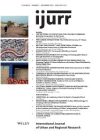The rent gap theory, a consistent explanation of gentrification in inner‐city spaces, sees a growing disparity between capitalized ground rent (CGR) and potential ground rent (PGR) as a catalyst for large‐scale property reinvestment and thence gentrification. In historical working‐class Santiago’s peri‐centre (inner city), not only is there a measurable rent gap, but a state‐subsidized market in high‐density urban renewal based on the accumulation of increased CGR by a few large‐scale developers. This article focuses on a low‐income municipality of Santiago, which has a local government that aims to attract this market via the liberalization of its local building regulations (seeking to increase the PGR), and deliberate underperformance in a national programme for housing upgrading (seeking to devalue the CGR in spaces previously targeted for renewal). It is observed how, in this city, two forms of ground rent exist, a lower one capitalized by current owner‐occupiers (CGR‐1) and a higher one capitalized by the market agents of renewal (CGR‐2). This is seen as a form of social dispossession of the ground rent and a necessary condition for gentrification. It is concluded that the state‐led strategy of urban renewal in Santiago needs to be refocused on more participative forms of distribution of the rent gap.
Details
Written by:
ERNESTO LOPEZ‐MORALES
Digital Object Identifier (DOI)
10.1111/j.1468-2427.2010.00961.x
About DOI
Read full article as PDF
Read full article as HTML
See the references for this article
